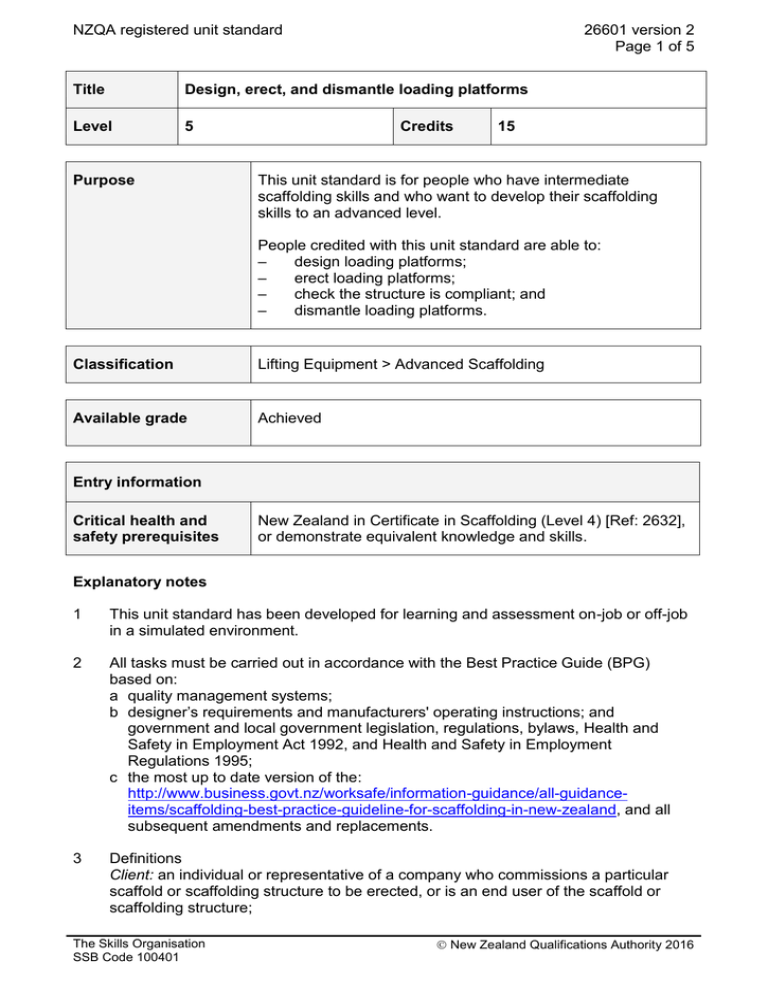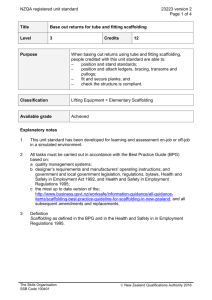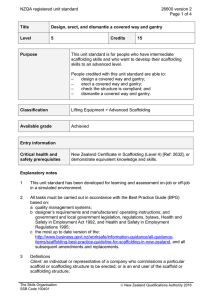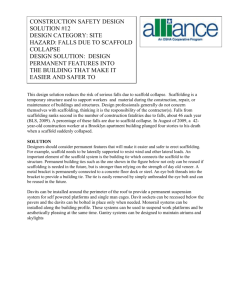NZQA registered unit standard 26601 version 2 Page 1 of 5
advertisement

NZQA registered unit standard 26601 version 2 Page 1 of 5 Title Design, erect, and dismantle loading platforms Level 5 Purpose Credits 15 This unit standard is for people who have intermediate scaffolding skills and who want to develop their scaffolding skills to an advanced level. People credited with this unit standard are able to: – design loading platforms; – erect loading platforms; – check the structure is compliant; and – dismantle loading platforms. Classification Lifting Equipment > Advanced Scaffolding Available grade Achieved Entry information Critical health and safety prerequisites New Zealand in Certificate in Scaffolding (Level 4) [Ref: 2632], or demonstrate equivalent knowledge and skills. Explanatory notes 1 This unit standard has been developed for learning and assessment on-job or off-job in a simulated environment. 2 All tasks must be carried out in accordance with the Best Practice Guide (BPG) based on: a quality management systems; b designer’s requirements and manufacturers' operating instructions; and government and local government legislation, regulations, bylaws, Health and Safety in Employment Act 1992, and Health and Safety in Employment Regulations 1995; c the most up to date version of the: http://www.business.govt.nz/worksafe/information-guidance/all-guidanceitems/scaffolding-best-practice-guideline-for-scaffolding-in-new-zealand, and all subsequent amendments and replacements. 3 Definitions Client: an individual or representative of a company who commissions a particular scaffold or scaffolding structure to be erected, or is an end user of the scaffold or scaffolding structure; The Skills Organisation SSB Code 100401 New Zealand Qualifications Authority 2016 NZQA registered unit standard 26601 version 2 Page 2 of 5 Loading platforms: platforms on a scaffold which are built to take repeated dynamic load and to store materials and equipment. The design, erection, and dismantling of loading platforms is an advanced scaffolding function which may be achieved with the use of either: tube and fitting scaffolding components or proprietary systems. The specifications of loading platforms often need to be checked by a chartered engineer. The circumstances in which this is required are set out in the BPG or, for proprietary systems, in the manufacturer’s specifications; Restored or repaired: the steps taken to ensure the end state of the supporting structure in accordance with site requirements; A scaffold plan: a key design document prepared by the candidate and used as a basis for the erection of a particular scaffold; Scaffolding as defined in the BPG and in the Health and Safety in in Employment Regulations 1995. 4 Assessment During assessment against this unit standard, the erection and dismantling of scaffolds and scaffolding structures must take place under the supervision of a certified scaffolder who holds a current Certificate of Competence for the scaffolding concerned. 5 Range Evidence is required for two loading platforms, one erected using tube and fitting components, and one erected using a proprietary system with additional tube and fitting components if required. At least one of these loading platforms must be a special duty loading platform. Outcomes and evidence requirements Outcome 1 Design loading platforms. Evidence requirements 1.1 Confirm loading platform scaffold requirements with the client or registered engineer. Range 1.2 includes – confirmation of load type and nature (dead, live, dynamic), establishing maximum load, extension distance; may include but is not limited to – movement requirements and methods on the platform, duration of use, access to points of attachment. Check the supporting scaffold for its capacity to support the loading platform. Range The Skills Organisation SSB Code 100401 includes but is not limited to – confirmation of structural integrity; identification of attachment, tie, and bracing points including additional attachment and bracing requirements for loading needs. New Zealand Qualifications Authority 2016 NZQA registered unit standard 1.3 Determine design parameters including, where necessary, meeting chartered engineer’s requirements. Range 1.4 includes but is not limited to – capacity of ground to support loading platform, loading calculations, access, the placement and nature of bracing and attachment points including the presence of additional standards and ledgers and bracing for load support, intended use, regulatory requirements, safety margins. Prepare design documents including, where necessary, incorporating advice from a chartered engineer. Range 1.5 26601 version 2 Page 3 of 5 includes – scaffolding plan, gear list, and, where necessary, engineer’s requirements; may include but is not limited to – CAD printouts, work schedules, staffing allocation, WorkSafe New Zealand and local authority approvals, workplace-specific documentation. Submit where necessary, the scaffold plan and associated design documents to a chartered engineer for checking and adjustments made as required. Outcome 2 Erect loading platforms. Evidence requirements 2.1 Confirm design parameters on-site before work begins in accordance with the scaffold plan. Range includes but is not limited to – ground conditions, bracing and tie points and their structure, load weights and movement, bracing methods, direction and magnitude of forces, movement of personnel and materials. 2.2 Source the necessary equipment in accordance with the scaffold plan. 2.3 Base out the scaffold in accordance with the scaffold plan. 2.4 Erect lifts in accordance with the scaffold plan. 2.5 Brace and plank the scaffold in accordance with the scaffold plan. 2.6 Erect, brace and plank subsequent scaffolding and components in accordance with the scaffold plan. Range The Skills Organisation SSB Code 100401 may include but is not limited to – ramps for access and movement, gear for moving equipment, access points from the ground or associated scaffolds. New Zealand Qualifications Authority 2016 NZQA registered unit standard 26601 version 2 Page 4 of 5 Outcome 3 Check the structure is compliant. Evidence requirements 3.1 Check the structure for compliance in accordance with the scaffold plan. 3.2 Complete a BPG inspection report. 3.3 Make changes to the structure to ensure compliance and amend the BPG inspection report accordingly. Outcome 4 Dismantle loading platforms. Evidence requirements 4.1 Clear the scaffold of load. 4.2 Remove scaffolding components, bracing, and ties progressively from the outer and top-most points first. 4.3 Remove structural members and fittings progressively from the outer and topmost points first while maintaining protection from fall risk. 4.4 Restore or repair attachment points in accordance with site requirements. Replacement information Planned review date This unit standard, unit standard 26598, unit standard 26599, unit standard 26600, and unit standard 26602 replaced unit standard 4209 and unit standard 4211. 31 December 2019 Status information and last date for assessment for superseded versions Process Version Date Last Date for Assessment Registration 1 21 July 2011 31 December 2016 Review 2 16 July 2015 N/A Consent and Moderation Requirements (CMR) reference 0183 This CMR can be accessed at http://www.nzqa.govt.nz/framework/search/index.do. The Skills Organisation SSB Code 100401 New Zealand Qualifications Authority 2016 NZQA registered unit standard 26601 version 2 Page 5 of 5 Please note Providers must be granted consent to assess against standards (accredited) by NZQA, before they can report credits from assessment against unit standards or deliver courses of study leading to that assessment. Industry Training Organisations must be granted consent to assess against standards by NZQA before they can register credits from assessment against unit standards. Providers and Industry Training Organisations, which have been granted consent and which are assessing against unit standards must engage with the moderation system that applies to those standards. Requirements for consent to assess and an outline of the moderation system that applies to this standard are outlined in the Consent and Moderation Requirements (CMRs). The CMR also includes useful information about special requirements for organisations wishing to develop education and training programmes, such as minimum qualifications for tutors and assessors, and special resource requirements. Comments on this unit standard Please contact The Skills Organisation at reviewcomments@skills.org.nz if you wish to suggest changes to the content of this unit standard. The Skills Organisation SSB Code 100401 New Zealand Qualifications Authority 2016



